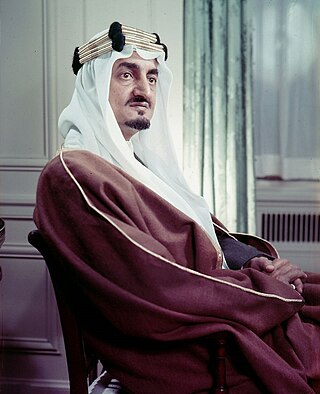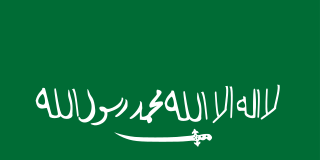| 1931 Saudi–Yemeni border skirmish | |||||||
|---|---|---|---|---|---|---|---|
| |||||||
| Belligerents | |||||||
Early in the year 1931, the Kingdom of Hejaz and Nejd, ruled by the House of Saud, engaged in an ill-documented border skirmish against the Mutawakkilite Kingdom of Yemen.
| 1931 Saudi–Yemeni border skirmish | |||||||
|---|---|---|---|---|---|---|---|
| |||||||
| Belligerents | |||||||
Early in the year 1931, the Kingdom of Hejaz and Nejd, ruled by the House of Saud, engaged in an ill-documented border skirmish against the Mutawakkilite Kingdom of Yemen.
All known details are provided on page 322 of St John Philby's 1955 book Saudi Arabia, which gives the following account: [1]
As had been the case before in the dispute over the ownership of the Khurma oasis, with King Husain taking the military initiative with a view to creating a fait accompli , it was the Imam Yahya who sought a settlement of the matters at issue with the Wahhabi king by pushing his troops into the areas claimed by him with the support of elements in both, which preferred weak Zaidi control to any closer acquaintance with the strom arm of Ibn Sa’ud. The inevitable clash of frontier guards ensued at a village called ’Aru early in 1931. In the absence of reliable maps at that time it was not easy to determine in this case which side was the aggressor, though before long it became clear that the blame lay with the Wahhabi commander, who had unwittingly trespassed into Yaman territory.
— St John Philby, Saudi Arabia
In an enquiry in 2017, the Correlates of War project was unable to find any further information, and found that The Times did not contain any mention of such incident in all of 1931. [2] Nonetheless, they still believed that such an incident had happened, since Philby was a close associate of Ibn Saud as well as a reputable British Arabist. [2]

The history of Saudi Arabia as a nation state began with the emergence of the Al Saud dynasty in central Arabia in 1727 and the subsequent establishment of the Emirate of Diriyah. Pre-Islamic Arabia, the territory that constitutes modern Saudi Arabia, was the site of several ancient cultures and civilizations; the prehistory of Saudi Arabia shows some of the earliest traces of human activity in the world.

Abdulaziz bin Abdul Rahman Al Saud, known in the West as Ibn Saud, was an Arab political and religious leader who founded Saudi Arabia – the third Saudi state – and reigned as its first king from 23 September 1932 until his death in 1953. He had ruled parts of the kingdom since 1902, having previously been Emir, Sultan, and King of Nejd, and King of Hejaz.

Faisal bin Abdulaziz Al Saud was a Saudi Arabian statesman and diplomat who was King of Saudi Arabia from 2 November 1964 until his assassination in 1975. Prior to his ascension, he served as Crown Prince of Saudi Arabia from 9 November 1953 to 2 November 1964, and he was briefly regent to his half-brother King Saud in 1964. He was prime minister from 1954 to 1960 and from 1962 to 1975. Faisal was the third son of King Abdulaziz, the founder of modern Saudi Arabia.

Harry St John Bridger Philby, CIE, also known as Jack Philby or Sheikh Abdullah, was a British Arabist, advisor, explorer, writer, and a colonial intelligence officer who served as an advisor to King Abdulaziz ibn Saud, the founder of Saudi Arabia.

The House of Saud is the ruling royal family of Saudi Arabia. It is composed of the descendants of Muhammad bin Saud, founder of the Emirate of Diriyah, known as the First Saudi state (1727–1818), and his brothers, though the ruling faction of the family is primarily led by the descendants of Abdulaziz bin Abdul Rahman, the modern founder of Saudi Arabia. It forms a subtribe of the larger prominent ancient Banu Hanifa tribe of Arabia, from which well known 7th century Arabian theologist Maslama ibn Ḥabīb originates. The most influential position of the royal family is the King of Saudi Arabia, an absolute monarch. The family in total is estimated to comprise 15,000 members; however, the majority of power, influence and wealth is possessed by a group of about 2,000 of them. Some estimates of the royal family's wealth measure their net worth at $1.4 trillion.This figure includes the market capitalization of Saudi Aramco, the state oil and gas company, and its vast assets in fossil fuel reserves, making them the wealthiest family in the world and the wealthiest in recorded history.
Abdulaziz bin Muhammad Al Saud was the second ruler of the Emirate of Diriyah. He was the eldest son of Muhammad bin Saud and the son-in-law of Muhammad bin Abdul Wahhab. Abdulaziz ruled the Emirate from 1765 until 1803. He was nicknamed by his people as the savior of his time due to his fearless activities.
Saud bin Abdulaziz Al Saud ruled the First Saudi State from 1803 to 1814. Saud annexed Mecca and Medina from the Ottoman Empire making him the first Al Saud ruler who received the title of the servant of the Two Holy Cities. During his rule the state experienced a significant level of strength and expansion for which he was called Saud Al Kabeer or Saud the Great.

Sunni Islam is the state religion of Saudi Arabia. The kingdom is called the "home of Islam"; it was the birthplace of the Islamic prophet Muhammad, who united and ruled the Arabian Peninsula. It is the location of the cities of Mecca and Medina, where Prophet Muhammad lived and died, and are now the two holiest cities of Islam. The kingdom attracts millions of Muslim Hajj pilgrims annually, and thousands of clerics and students who come from across the Muslim world to study. The official title of the King of Saudi Arabia is "Custodian of the Two Holy Mosques"—the two being Al-Masjid al-Haram in Mecca and Al-Masjid al-Nabawi in Medina—which are considered the holiest in Islam.

The Ikhwan, commonly known as Ikhwan man ata'a Allah, was a religious militia made up of traditionally nomadic tribesmen which formed a significant military force of the ruler Ibn Saud and played an important role in establishing him as ruler of most of the Arabian Peninsula in the Kingdom of Saudi Arabia.

The Saudi–Yemeni war was a war between Saudi Arabia and the Kingdom of Yemen in 1934.

The Unification of Saudi Arabia was a military and political campaign in which the various tribes, sheikhdoms, city-states, emirates, and kingdoms of most of the central Arabian Peninsula were conquered by the House of Saud, or Al Saud. Unification started in 1902 and continued until 1932, when the Kingdom of Saudi Arabia was proclaimed under the leadership of Abdulaziz, known in the West as Ibn Saud, creating what is sometimes referred to as the Third Saudi State, to differentiate it from the Emirate of Diriyah, the First Saudi State and the Emirate of Nejd, the Second Saudi State, also House of Saud states.
The Saudi government does not conduct a census on religion or ethnicity, but some sources estimate the Shia population in Saudi Arabia to make up around 20% of the approximately 34 million natives of Saudi Arabia.
The Al ash-Sheikh, also transliterated in a number of other ways, including Al ash-Shaykh, Al ash-Shaikh, Al al-Shaykh or Al-Shaykh is Saudi Arabia's leading religious family. They are the descendants of Muhammad ibn Abd al-Wahhab. In Saudi Arabia, the family is second in prestige only to the Saudi royal family, the Al Saud, with whom they formed a power-sharing arrangement nearly 300 years ago. The arrangement, which persists to this day, is based on the Al Saud maintaining the Al ash-Sheikh's authority in religious matters and the Al ash-Sheikh supporting the Al Saud's political authority.
Muhammad bin Saud Al Muqrin, also known as Ibn Saud, was the emir of Diriyah and is considered the founder of the First Saudi State and the Saud dynasty, which are named for his father, Saud bin Muhammad Al Muqrin. His reign lasted between 1727 and 1765.
Umm Al-Qura was the first Arabic language Saudi Arabian daily newspaper based in Mecca, and the official gazette of the Kingdom of Saudi Arabia. The paper has been in circulation since 1924.
The Najran conflict was a poorly documented conflict over Najran in the early 1930s fought between the Mutawakkilite Kingdom of Yemen and the Kingdom of Hejaz and Nejd.
Abdullah bin Faisal Al Saud was one of the rulers of the Emirate of Najd, also known as Second Saudi State. His reign witnessed extensive struggle among the members of the Al Saud family which led to turmoil in the region.
Ahmed bin Abdullah Al Thunayan (1889–1923) was a Turkish-born Saudi royal and government official who was one of the advisors to Abdulaziz, Emir of Nejd, who later founded the Kingdom of Saudi Arabia. He was the paternal uncle of Iffat Al Thunayan, spouse of King Faisal.
Abdullah bin Muhammad Al Sheikh (1751–1829) was a Muslim scholar who served as the head of the judicial system during the First Saudi State, also known as the Emirate of Diriyah. He was a son of Muhammad ibn Abd al-Wahhab, who was credited with introducing the so-called Wahhabi sect of Islam. Abdullah developed the doctrine of this religious belief. David Commins, an American scholar on Wahhabism, argues that Abdullah was the most significant figure among Muhammad's sons.

The Declaration of theUnification of Saudi Arabia was officially announced by Prince Faisal bin Abdulaziz, the Viceroy of Hejaz on behalf of King Abdulaziz ibn Saud on September 23, 1932, at 9:00 am from al-Hamidiyah Palace in Mecca. Faisal read out the Royal Decree No. 2716 issued by Abdulaziz ibn Saud on September 18, 1932, that renamed the Kingdom of Hejaz and Nejd and its annexes as the Kingdom of Saudi Arabia.